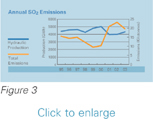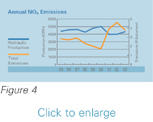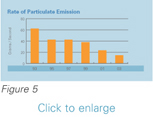|
The Holyrood Thermal Generating Station's wastewater treatment plant treats the wastewater resulting
from the combustion of fuel, and runoff from the solid waste landfill. Constituents of the wastewater
from the plant are measured and compared to regulatory limits. Once all aspects of the wastewater are
compliant, the wastewater is released into the environment. In 2003, a total of 6.22 million litres of
wastewater was treated and discharged, which is a decrease from the 7.26 million litres of wastewater
processed in 2002.
Hydro relies on both hydroelectric and thermal generation to meet customer needs. The operation of
Holyrood is highly dependent on the availability of water in our hydroelectric reservoirs. Water levels
in our reservoirs vary from year to year with the amount of precipitation and runoff. As water levels
increase in the reservoirs, the demand on thermal generation decreases, as well as the associated air
emissions.
Hydraulic production was 4,338 GWh in 2003, up 8.4 per cent from 2002. This was the result of increased
reservoir inflows and the addition of the Granite Canal Hydroelectric Generating Station to the system.
Purchases of energy also increased by 79.5 percent to 295 GWh, primarily a result of new non-utility
generating sources being brought into service by Corner Brook Pulp and Paper and the Exploits River Hydro
Partnership.
The combined increases in hydraulic generation and energy purchases offset by some modest increase in
Island system sales resulted in an 18 per cent reduction in production compared to 2002 from Holyrood to
2,061 GWh. This resulted in a reduction of No. 6 fuel oil consumption to 3,074,000 barrels. The total
emission of carbon dioxide (CO2), sulphur dioxide
(SO2), and nitrogen oxide (NOX) therefore
decreased in 2003. Figures 2, 3 and 4 show the relationship between hydraulic production and atmospheric
emissions.
|

|

|

|
|
|
|
|
|
The average rate of particulate emissions at high load at Holyrood was measured in 2003, and comparative
results from previous years are shown in Figure 5. Improvements were achieved in recent years as a result
of technological improvements in our fuel burners, by increasing operating efficiencies, and by optimizing
the use of the plant for the electrical needs on the Island Interconnected System.
|

|
Stack emission testing, conducted every two years, was performed on the three generating units at Holyrood
during 2003. The tests monitor particulate, particulate particle size, metals, sulphates,
SO2, NOX, carbon
monoxide (CO), and CO2 in the exhaust-gas.
Test results are reported to the provincial Department of Environment and Conservation to satisfy an
existing agreement, and are used for on-site evaluation, the annual report on air emissions, and
exhaust-gas modeling. The results also provide data on our initiatives to improve overall unit performance
and efficiency.
In 2003, Continuous Emission Monitors (CEM) were installed on the three units at the Holyrood Thermal
Generating Station. The CEMs are intended to continuously monitor
SO2, NOX, CO,
CO2, and oxygen (O2) in
the exhaust-gas. The data collected will be used to monitor and improve overall unit performance
and efficiency.
|
